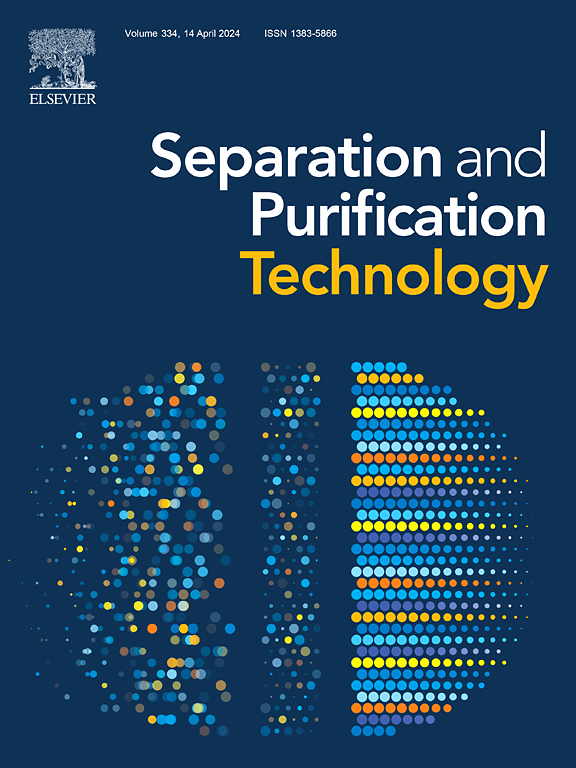fe -n共掺杂生物炭/碳量子点p-n异质结材料光催化降解磺胺类和氟喹诺酮类抗生素
IF 8.1
1区 工程技术
Q1 ENGINEERING, CHEMICAL
引用次数: 0
摘要
磺胺类和氟喹诺酮类抗生素的滥用导致水环境污染,因此必须开发成本效益高、效率高的降解方法。本文采用一步水热法(200℃,8 h)制备了Fe-N共掺杂生物炭/碳量子点(Fe/N/BC/CQDs)作为光催化材料。利用Fe/N/BC/CQDs活化H2O和O2,促进磺胺类和氟喹诺酮类抗生素的降解,其中超氧自由基、光生空穴、羟基自由基和单线态氧主导了光降解过程。在1 h暗光和8 h自然光条件下,Fe/N/BC/CQDs对诺氟沙星、磺胺噻唑、磺胺甲恶唑、磺胺甲恶嘧啶、磺胺多辛、磺胺甲恶嗪(10 mg/L)的降解效率为74.21 % ~ 89.23 %。通过对磺胺类和氟喹诺酮类抗生素中间体的超高效液相色谱串联高分辨质谱分析,提出了其潜在的降解途径。fe - n掺杂生物炭的分层孔结构增强了协同吸附催化效果,而碳量子点(CQDs)扩大了太阳光谱的利用,有效克服了传统光催化剂的高强度光依赖性。通过在fe -n共掺杂生物炭和CQDs之间形成p-n异质结实现了有效的电荷分离。此外,还证实了Fe/N/BC/CQDs在实际水系统中的适用性,为构建降解水中有机污染物的p-n异质结结构提供了有价值的见解。本文章由计算机程序翻译,如有差异,请以英文原文为准。

Photocatalytic degradation of sulfonamide and fluoroquinolone antibiotics by Fe-N-co-doped biochar/carbon quantum dots p-n heterojunction materials
The misuse of sulfonamide and fluoroquinolone antibiotics leads to pollution of the water environment, necessitating the development of cost-effective and efficient degradation methods. This article presents a one-step hydrothermal method (200℃, 8 h) for the preparation of Fe-N-co-doped biochar/carbon quantum dots (Fe/N/BC/CQDs) as a photocatalytic material. The Fe/N/BC/CQDs was employed for the activation of H2O and O2, facilitating the degradation of sulfonamide and fluoroquinolone antibiotics, with superoxide radicals, photo-generated holes, hydroxyl radicals, and singlet oxygen dominated the photodegradation process. Under 1 h dark and 8 h natural light conditions, the degradation efficiency of norfloxacin, sulfathiazole, sulfamethoxazole, sulfamonomethoxine, sulfadoxin, sulfamethazine (10 mg/L) by Fe/N/BC/CQDs ranged from 74.21 % to 89.23 %. The potential degradation pathways of sulfonamide and fluoroquinolone antibiotics were proposed based on ultrahigh-performance liquid chromatography tandem high-resolution mass spectrometry analysis of the intermediates. The Fe-N-doped biochar’s hierarchical pore structure enhances synergistic adsorption-catalysis effects, while the incorporated carbon quantum dots (CQDs) broaden solar spectrum utilization, effectively overcoming the high-intensity light dependency common to conventional photocatalysts. Efficient charge separation was achieved through the formation of a p-n heterojunction between Fe-N-co-doped biochar and CQDs. Additionally, the applicability of Fe/N/BC/CQDs in real water systems was confirmed, providing valuable insights for the construction of p-n heterojunction structures to degrade organic pollutants in water.
求助全文
通过发布文献求助,成功后即可免费获取论文全文。
去求助
来源期刊

Separation and Purification Technology
工程技术-工程:化工
CiteScore
14.00
自引率
12.80%
发文量
2347
审稿时长
43 days
期刊介绍:
Separation and Purification Technology is a premier journal committed to sharing innovative methods for separation and purification in chemical and environmental engineering, encompassing both homogeneous solutions and heterogeneous mixtures. Our scope includes the separation and/or purification of liquids, vapors, and gases, as well as carbon capture and separation techniques. However, it's important to note that methods solely intended for analytical purposes are not within the scope of the journal. Additionally, disciplines such as soil science, polymer science, and metallurgy fall outside the purview of Separation and Purification Technology. Join us in advancing the field of separation and purification methods for sustainable solutions in chemical and environmental engineering.
 求助内容:
求助内容: 应助结果提醒方式:
应助结果提醒方式:


